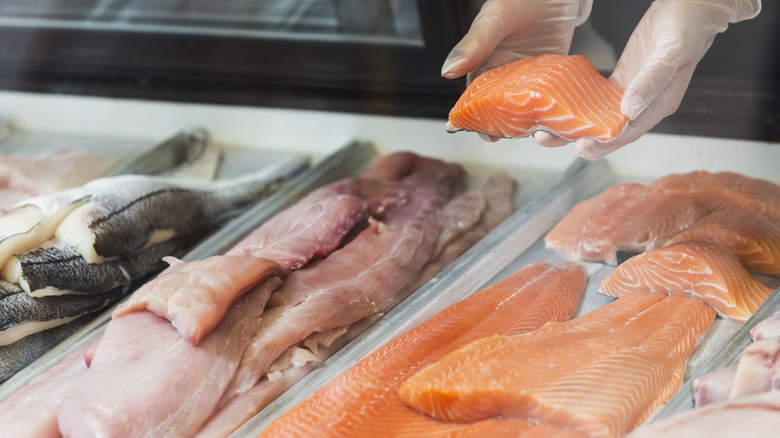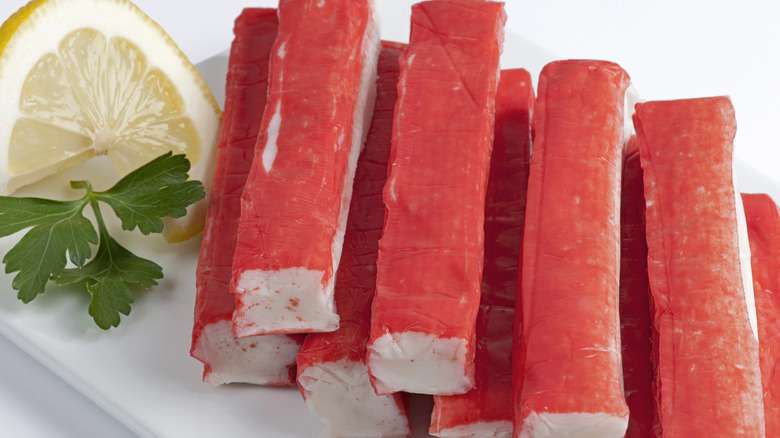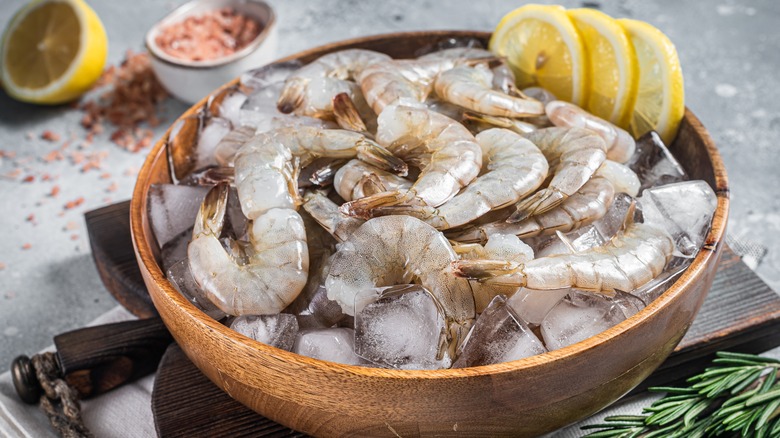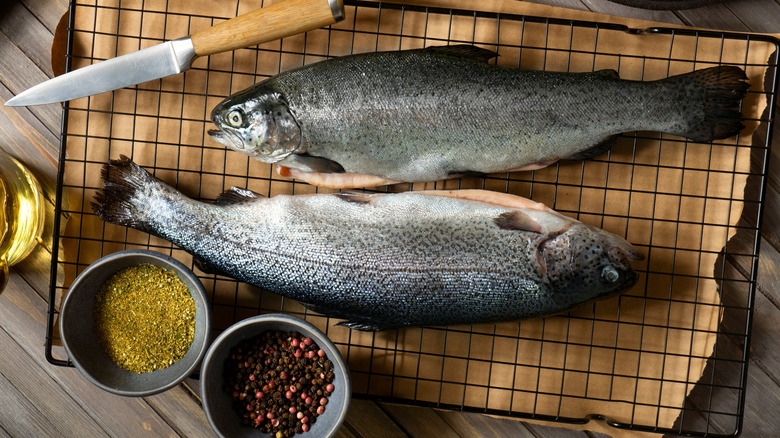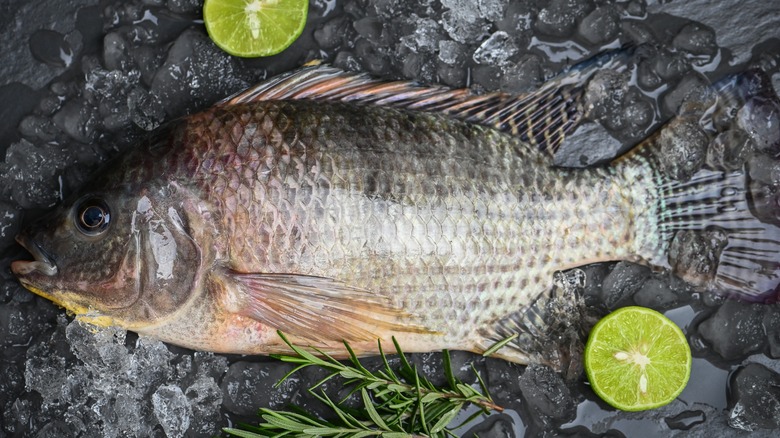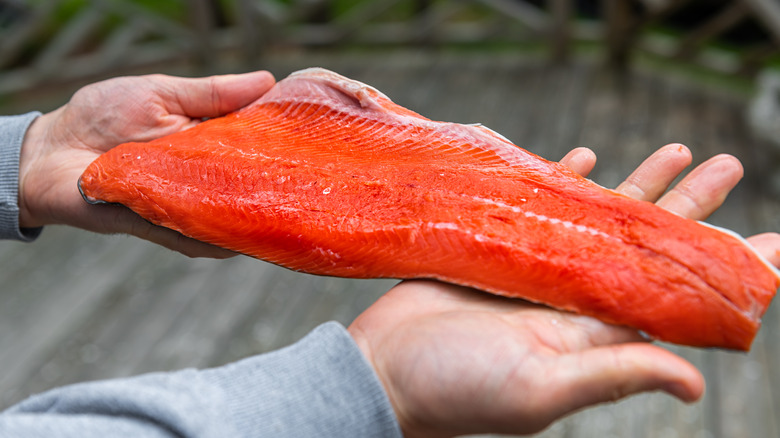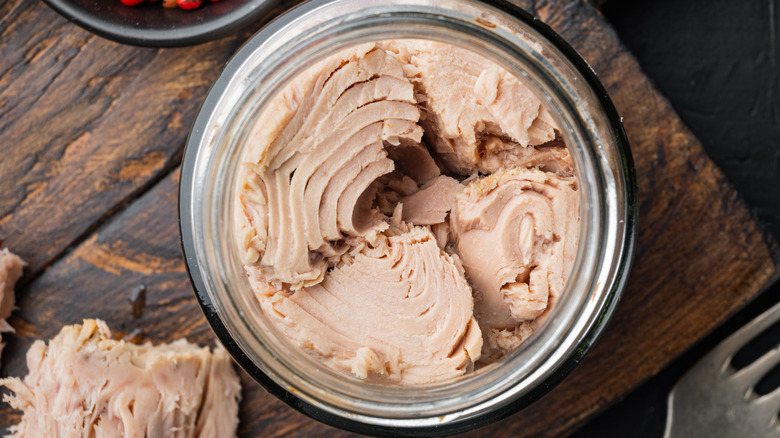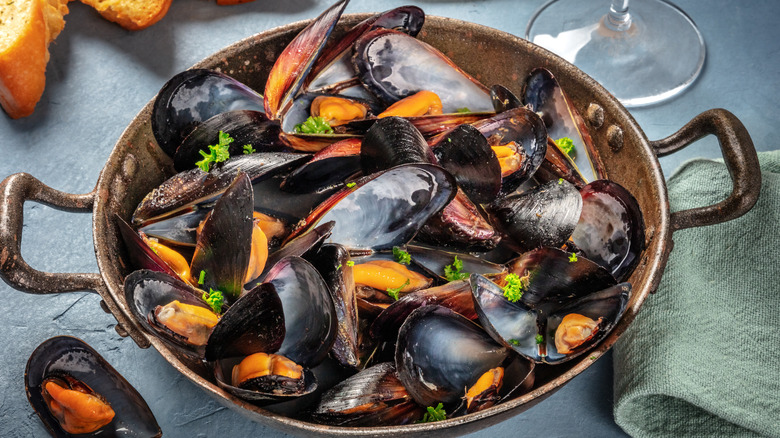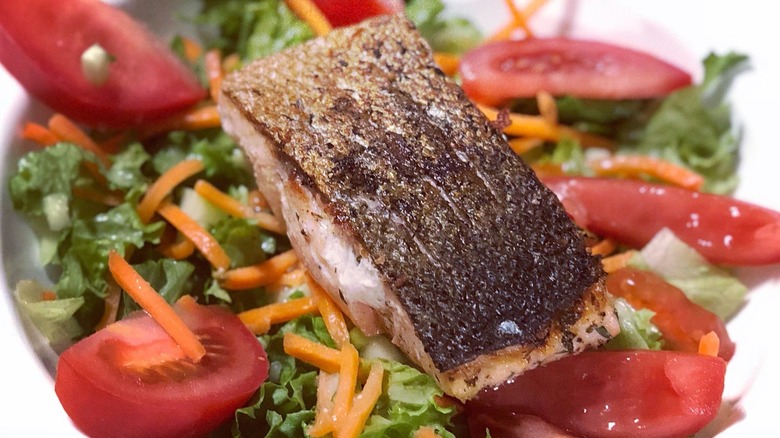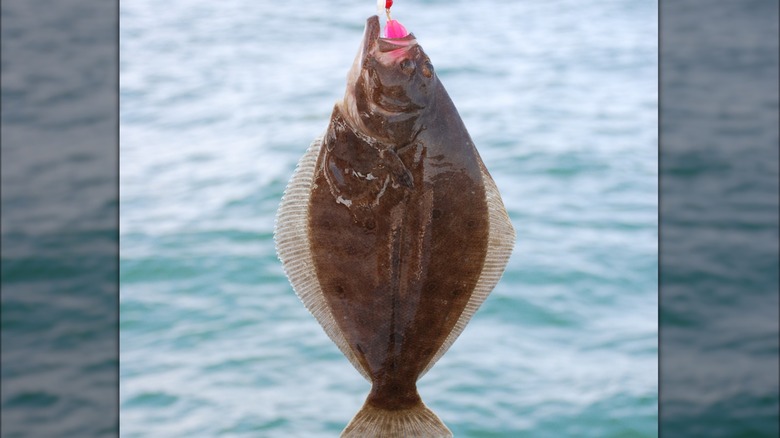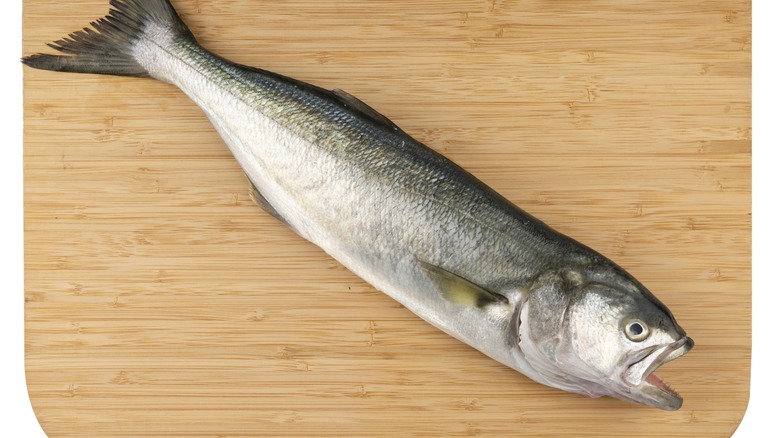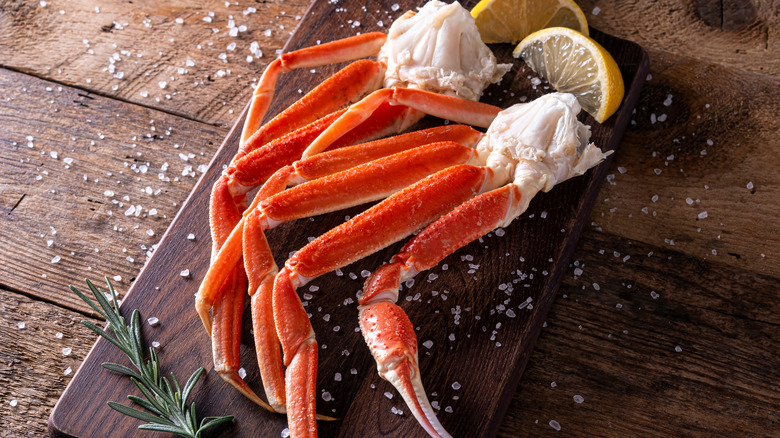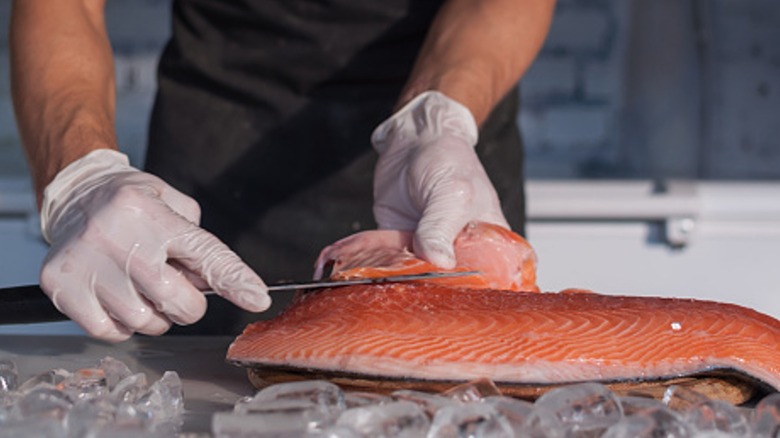Budget-Friendly Seafood Items You'll Actually Enjoy Eating
Seafood isn't exactly known for being inexpensive. In fact, it's often considered one of the more expensive types of food to spend your money on, mostly because many types of seafood are difficult to catch and keep fresh until they reach their destination. These challenges increase the end costs for consumers trying to buy seafood at the grocery store or in a restaurant.
However, seafood costs can fluctuate significantly throughout the year and between years. Factors like weather, farming techniques, and location can all play a role in the price of seafood. Of course, the economy has one of the biggest impacts on the price of seafood. While that salmon you've been eyeing might have been outside of your budget a couple of months ago, it could be more affordable now. It's important to remember that the seafood we list here — and, really, any food — could be affected by economic fluctuations in the future, so it's important to check your local pricing and stay up-to-date with current events shaping the seafood industry.
With that said, we've gathered a list of budget-friendly seafood items that are generally more affordable than others at the grocery store or local fish market.
Surimi in the form of imitation crab
Yes, surimi is deboned fish flesh that gets made into imitation crab. Yes, you can argue that this isn't necessarily real seafood. But it partly is, and it tastes quite a bit like the real thing. It's one of those "don't knock it until you've tried it" type of things.
Plus, imitation crab is much cheaper than the real thing because it's not the real thing. Still, it has a similar texture, bite, and flavor, making you feel like you're snacking on real crab. Drizzle imitation crab with melted butter, chop it up to mix into a crab salad, or add diced imitation crab to homemade crab soup.
Although imitation crab won't give you the same nutrition profile as real crab — according to Healthline, it's much lower in protein, vitamin B12, and folate, and it's higher in carbs — the price difference is incomparable. For instance, as of September 2023, real crab meat at Sam's Club is almost $25 per pound, while a package of imitation crab is just slightly over $3 per pound.
Frozen shrimp
If your local grocery store has a fresh seafood counter or you have a nearby fish market, you can probably find some fresh-never-frozen shrimp. However, be prepared for some sticker shock when you look at the price. Never-frozen shrimp are usually much more expensive than frozen shrimp because of the extra steps needed to preserve them properly until they reach the customers' shopping bags.
Meanwhile, packs of frozen shrimp at Walmart are available for about $6 for 12 ounces as of September 2023. If you buy bigger bags, you can usually reduce the cost per ounce, giving you more shrimp for less money. Buying frozen shrimp doesn't do much to change the dish you're using them in, either. Although fresh shrimp typically have a bit stronger taste, frozen shrimp are still full of flavor and easy to cook. Plus, they take only a few minutes to thaw and are ready for use after running them under cold water.
For the biggest savings, look for uncooked frozen shrimp with the tails on, and buy bags of smaller shrimp — usually labeled as small or medium — if it makes sense for your recipe. For example, you might want larger shrimp if you're eating them on their own, but if you're putting them in chowder or a pasta dish, you can probably get away with smaller, more affordable frozen shrimp.
Trout
Several species of salmon exist, with some being more affordable than others. Salmon is generally known as being somewhat pricey compared to other fish, yet some people choose to buy it because they prefer pink-fleshed fish over white-fleshed. If this is you, but salmon is currently out of your budget, consider trout.
Like salmon, trout typically has pink-red flesh because of the algae it eats, and it has a similar flavor and texture. However, it's generally a few dollars less per pound than salmon, making it a more affordable option for budget-conscious shoppers looking to enjoy fish in their meal rotations. Trout tends to be farmed more easily than salmon, making it more readily available and reducing its costs to consumers. If you want the most similar-to-salmon taste, one Redditor suggests ocean trout: "It's the same species as the freshwater [version], but some of the trout migrate to live in salt water. The flavor is more similar to salmon, I think, and less muddy."
Tilapia
All kinds of rumors have circulated around tilapia for years. You might have heard that it's not safe to eat, it's bad for the environment, or it's not even a real fish. In fact, tilapia is a real fish that's commercially farmed. And, when farmed properly and ethically, tilapia is just as safe and healthy to eat as many other fish. According to Medical News Today, tilapia has about the same risk as other fish of containing harmful chemicals from contaminated feed, which is why it's important to know where your fish comes from and how it's raised.
Now that we've debunked the myths, let's dig into why tilapia is so cheap. Tilapia is one of the easiest fish to farm because it can continue to thrive in crowded environments and doesn't really need much care to grow quickly. Therefore, fish farmers can grow more tilapia than other fish in shorter amounts of time. According to Selina Wamucii data, the September 2023 price of tilapia in the United States is between $1.36 and $2.72 per pound, a drastic difference from other types of fish.
Alaska sockeye salmon
For the past couple of years, Seafood Source reports that Alaska sockeye salmon has seen record-breaking harvests in many areas where it's fished. In fact, catches from Bristol Bay, which sits on the southwestern side of Alaska, set a record last year; statewide, the haul was 36% higher in 2022 than 2021. That surplus carried over into 2023, creating a continued surplus for the fish. Although salmon is often a more expensive seafood catch, as long as a surplus of Alaska sockeye salmon exists, we can expect its price to be lower than the norm as suppliers try to encourage more purchases to use up their inventories.
In early 2023, consumers were paying about 7% less per pound for Alaska sockeye salmon compared with a year earlier, while farmed Atlantic salmon continued to rise in price (via Seafood Source).
While this fish isn't necessarily what we'd consider cheap, it's a budget-friendlier option than other types of salmon in the current market. Depending on where you buy from, you can typically find Alaska sockeye salmon for about $13-$22 per pound as of September 2023, making it an option to consider for an occasional treat.
Canned tuna
Why pay dollars per pound of seafood when you can find store-brand cans of tuna for under $1 each? With four servings of tuna in each can, you can spread your tuna sandwiches, wraps, and salads over several days to really stretch your dollar.
According to Andrew F. Smith, the author of "American Tuna: The Rise and Fall of an Improbable Food" (via HuffPost), canned tuna is often not "real" tuna. Instead, it's a fish known as skipjack, which, although not an actual tuna species, is considered by the U.S. Food and Drug Administration to be one, along with albacore. Still, the flavor of these fish very much resembles tuna, but they're easy and quick to grow, helping reduce the price of that canned tuna.
So, stock up on all the varieties of canned tuna to get your seafood fix, just be sure to avoid those common mistakes people make with canned tuna. In addition to being a tasty addition to lunch or dinner, it's super versatile for pasta dishes, casseroles, salads, and more. Plus, canned tuna is an excellent, affordable source of protein and omega-3 fatty acids.
Mussels
Mussels are similar to clams in texture, taste, and effort needed to get the meat out of them. However, they're often at least $1 or $2 cheaper per pound than clams because they're generally quicker to grow and easier to cultivate. So, there's less work that goes into catching a bunch of mussels to sell versus clams.
Don't think that mussels are any less delectable to eat just because they're less expensive. Some people actually prefer mussels to clams because they're a bit milder in flavor and have a slightly chewier bite. If you're using the meat from mussels in a chowder or another dish with several other ingredients, you're probably not going to notice any difference compared with clams.
As a bonus, Paul Greenberg, author of "The Climate Diet," reports on Food52 that mussels are among the most eco-friendly seafood to catch, with emissions stats that rival many vegetables with their low carbon footprints. Affordable and sustainable seafood? Count us in.
Monkfish
Never heard of monkfish? You're not alone, and there's a good reason why you haven't. Monkfish are one of the more terrifying-looking creatures in the sea. Their heads take up a good portion of their bodies, which are relatively flat in appearance, and they have large mouths with rows of pointed teeth. Seeing one in the water might be enough to keep you out of the ocean forever.
The good news is, if you eat monkfish, you won't ever have to see how unappealing they look, and their flavor is nothing like their appearance. In fact, to many, monkfish are comparable to lobster, enough so for some to call them the poor man's lobster. Monkfish can grow up to five feet long, offering much more meat than a lobster can produce, which contributes to their more affordable price tag.
Although, like other seafood, monkfish and lobster prices vary by location, monkfish are generally at least half the price of lobster. For example, All Fresh Seafood, an online seafood retailer, sells monkfish filets for $18.99 per pound, while fresh lobster knuckle and claw meat sells for $59.99 per pound as of September 2023.
Frozen, skin-on salmon filets
To skin or not to skin salmon? Ultimately, it comes down to personal preference. Some people like the skin because it crisps up during the cooking process, especially when baking, air frying, or pan-searing. Others prefer to eat their salmon skinless, which tends to be more common when eating it raw or using it for sushi.
But if you want to save money on salmon, consider buying it with the skin on. Keeping the skin on is one less step manufacturers need to make when packaging salmon to sell, reducing the cost to the consumer. Take salmon filets from Wild Fork Foods as an example. As of September 2023, the company sells its skinless Atlantic salmon filets for $16.98 for 1.5 pounds, but its skin-on filets are $2 cheaper. Buying skin-on filets frozen can knock the price down even more, as frozen salmon doesn't have as much risk of food waste as fresh salmon. For example, as of September 2023, Walmart sells its 2-pound bag of Great Value skin-on frozen salmon filets for just $6.99 per pound.
If you're not a fan of the skin, you can always thaw the filets using the manufacturer's suggested method and use a filet knife to carefully remove the skin.
Fluke
Also known as summer flounder, fluke is a flatfish found in the Atlantic Ocean. It has white flesh and is similar in taste to tilapia and halibut. Fluke can grow relatively fast, especially during the summer months, and females can weigh up to 20 pounds, both of which are factors contributing to their affordable price tags. The population of fluke has grown steadily over the past few decades, too, thanks to their reproduction rates and the more sustainable fishing processes (per NOAA Fisheries).
The price of fluke hit a record low in 2021 after the pandemic when fisheries saw healthy catching seasons and lower-than-usual demand for the fish. During that year, the price ranged from about $2.50 per pound to $5 per pound (via National Fisherman). Although the market has balanced out more since then, fluke is still relatively inexpensive compared to pricier seafood like crab, lobster, and wild-caught salmon. As of September 2023, the price of fluke generally ranges from $12 to $18 per pound.
King mackerel
NOAA Fisheries reports king mackerel as one of the most sustainable fish to catch because its fishing market and practices are well managed and the techniques used to catch it don't harm the environment. But if you're looking for another reason to love king mackerel, consider its price tag. For 2023, Selina Wamucii lists the average price per pound of king mackerel between $2.72 and $5.44, much less than what you would pay for more popular seafood, like clams, lobster, or halibut. King mackerel is fast growing and can weigh up to about 100 pounds, offering plenty of flesh to go around and drive down prices.
King mackerel has a strong flavor, so it's not necessarily the best choice for seafood enthusiasts who enjoy milder tastes. However, it works well for dishes needing a strong seafood star. Marinating and grilling king mackerel is a top choice, but people also transform it into sashimi or turn it into jerky strips using a smoker.
Bluefish
Bluefish are a little different than other types of seafood on our list. Although they are, in fact, an affordable fish, they have just a short window of time in which proponents say they're an enjoyable eat. According to author Paul Greenberg (via The New York Times), bluefish releases a compound within a few days of being caught that gives them an oily texture and flavor. Ideally, the best time to eat them is one or two days after they're freshly caught, which typically happens when people catch bluefish themselves. But if you live on the East Coast, where bluefish populations run rampant over the summer, you might be lucky enough to find freshly caught bluefish at your local fish market to enjoy when they're at their best.
If that's the case, you'll also enjoy some of the best prices for bluefish, too, as they tend to be the lowest on the East Coast, where they're typically caught. As of September 2023, you can find bluefish for around $5 to $9 per pound.
Frozen snow crab
Snow crab has often been one of the more expensive yet desirable seafood items to buy. But after seafood imports from Russia into the United States were cut off in early 2022, snow crab prices rose as the United States looked for other options to boost its supply. By January 2023, SeafoodSource reports that the price per pound of snow crab dropped by more than half of what it was the previous year to about $7 per pound — an affordable price for a type of seafood that's usually out-of-budget for many people.
The prices could remain about the same for a while as Canada's supply is projected to continue seeing healthy numbers for the foreseeable future (via SeafoodSource). As of September 2023, Selina Wamucii reports the average price of snow crab in the United States is between $5.90 and $10.88 per pound. You might find the best prices in the frozen section of the grocery store, where the average price has dropped in 2023 (via SeafoodSource).
Fish trimmings
We're aware that eating the leftovers of trimmed fish doesn't sound very appetizing, but if you're really budget-conscious, you won't want to miss out on fish trimmings. They are what's left when the fish gets cut into filets, tails, or however it needs to be packaged. Trimmings might include heads, fins, and leftover scraps of meat that didn't fit cleanly into a filet. As you can guess, these leftovers don't cost nearly as much as the fish filets that get displayed at a seafood counter. That's why they're usually bought to use as cheap animal feed.
However, some people routinely seek out fish trimmings to eat. Certain kinds, like leftover strips of salmon, are quite popular to use in dishes without paying the price you'd usually pay for cleanly cut filets. For example, one Redditor made sashimi from leftover cuts they had after portioning filets. You can also transform fish trimmings into a fish stock for various meals or make it into fish broth for soups or gravies. Scientists have even experimented with grinding fish trimmings into powders as protein supplements. If you're feeling creative in the kitchen, grab that package of fish trimmings from your local seafood market — it'll likely be just a few dollars per pound — and see what you can come up with.
